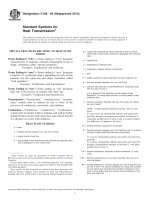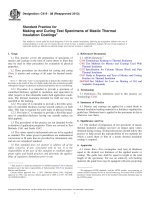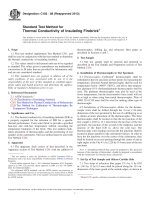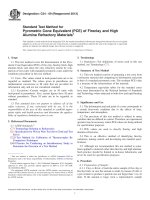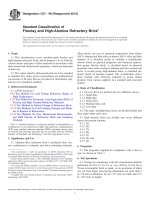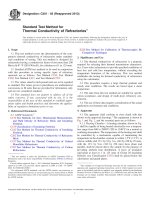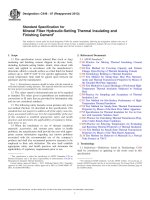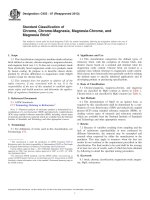Astm c 492 92 (2013)
Bạn đang xem bản rút gọn của tài liệu. Xem và tải ngay bản đầy đủ của tài liệu tại đây (57.5 KB, 2 trang )
Designation: C492 − 92 (Reapproved 2013)
Standard Test Method for
Hydration of Granular Dead-Burned Refractory Dolomite1
This standard is issued under the fixed designation C492; the number immediately following the designation indicates the year of
original adoption or, in the case of revision, the year of last revision. A number in parentheses indicates the year of last reapproval. A
superscript epsilon (´) indicates an editorial change since the last revision or reapproval.
oped between two parties if sufficient care in establishing the
bias between the laboratories is carried out.
1. Scope
1.1 This test method covers the determination of the amount
of hydration of a granular dead-burned refractory dolomite
when exposed to moist air.
4. Apparatus
4.1 Sieve, ASTM No. 40 (425-µm) (equivalent to a 35-mesh
Tyler Standard Series) conforming to Specification E11, with
pan and cover.
1.2 The values stated in inch-pound units are to regarded as
the standard. The values given in parentheses are for information only.
1.3 This standard does not purport to address all of the
safety concerns, if any, associated with its use. It is the
responsibility of the user of this standard to establish appropriate safety and health practices and determine the applicability of regulatory limitations prior to use.
4.2 Glass Petri Dishes, 95 by 20-mm.
4.3 Circulating Hot-Air Oven, capable of operating at 220 to
230°F (104 to 110°C).
4.4 Steam-Humidity Cabinet, to be maintained at 160 6 2°F
(71 6 1°C) and 85 6 3 % humidity.3
4.5 Scale, having a capacity of 200 g, accurate to 0.02 g.
2. Referenced Documents
2.1 ASTM Standards:2
C92 Test Methods for Sieve Analysis and Water Content of
Refractory Materials
E11 Specification for Woven Wire Test Sieve Cloth and Test
Sieves
5. Sampling
5.1 The sample used shall be quartered or riffled so that it is
typical of the material being tested both in screen size and
oiling. All material passing the No. 40 (425-µm) sieve shall be
removed from this sample by screening. All screening shall be
done in accordance with Test Methods C92 for dry sieve
analysis.
3. Significance and Use
3.1 The hydration of dead-burned dolomite grains is an
important aspect of both manufacturing and using such grains.
Moisture from any source will cause the grains to partially
disintegrate, eventually making the dead-burned dolomite unfit
for use. This test method may prove useful for determining, in
a relative manner, which grains are more resistant to hydration
than others.
6. Procedure
6.1 Place a 100 6 0.1-g portion of the representative sample
retained on the No. 40 (425-µm) sieve sample in a 95 by
20-mm Petri dish. Then place this dish in a hot-air oven for 1⁄2
h at 220 to 230°F (104 to 110°C) to prevent condensation of
water on the sample when placed in a hot steam-humidity
cabinet.
3.2 Data from one laboratory might help in establishing
internal limits for determining whether a particular batch of
grain is suitable for refractory production. However, this test
method takes great care to run, and is not recommended as a
quality control test. Possibly, a specification might be devel-
6.2 Transfer the Petri dish containing the sample from the
hot-air oven to the steam-humidity cabinet, and cover with a
glass plate at an angle of 45° to prevent dripping on the sample.
The edges of the glass plate shall overhang the Petri dish by
about 3⁄4 in. (19 mm).
6.3 Maintain the steam-humidity cabinet at 160 6 2°F (71
6 1°C) and 85 6 3 % humidity for 24 h. The time to reach
these conditions shall be approximately 1⁄2 h. Then immediately remove the Petri dish from the cabinet and place in a
1
This test method is under the jurisdiction of ASTM Committee C08 on
Refractories and is the direct responsibility of Subcommittee C08.04 on Chemical
Behaviors.
Current edition approved April 1, 2013. Published August 2013. Originally
approved in 1962. Last previous edition approved in 2008 as C492 – 92 (2013).
DOI: 10.1520/C0492-92R13.
2
For referenced ASTM standards, visit the ASTM website, www.astm.org, or
contact ASTM Customer Service at For Annual Book of ASTM
Standards volume information, refer to the standard’s Document Summary page on
the ASTM website.
3
An apparatus manufactured by the American Instrument Co., 8030 Georgia
Ave., Silver Spring, MD, or the Electric Hotpack Co., Philadelphia, PA, has been
found suitable for this purpose.
Copyright © ASTM International, 100 Barr Harbor Drive, PO Box C700, West Conshohocken, PA 19428-2959. United States
1
C492 − 92 (2013)
TABLE 1 Precision Data
Material
Number
Average, X¯
Standard
Within, Sr
Deviation
Between, SR
Repeatability
Interval, r
Reproducibility
Interval
1
2
3
23.94
4.820
3.645
0.8752
0.2325
0.1355
1.513
0.5299
0.3007
2.450
0.6510
0.3795
4.236
1.484
0.8419
Coefficient of Variation
Within Lab,
Vr
Between Labs,
VR
Relative
Repeatability,
%r
Relative
Reproducibility,
%R
3.656
4.824
3.717
6.320
10.99
8.250
10.23
13.51
10.41
17.69
30.79
23.10
variation). The 95 % repeatability intervals are given in Table
1. Two test results that do not differ by more than the
repeatability interval will be considered to be from the same
population, and, conversely, two test results that do differ by
more than the repeatability interval will be considered to be
from different populations.
8.2.2 Reproducibility—The maximum permissible difference due to test error between two test results obtained by two
operators in different laboratories on the same type of material
using the same type of test equipment is given by the
reproducibility interval and relative reproducibility interval
(coefficient of variation). The 95 % reproducibility intervals
are given in Table 1. Two test results that do not differ by more
than the reproducibility interval will be considered to be from
the same population, and, conversely, two test results that do
differ by more than the reproducibility interval will be considered to be from different populations.
hot-air oven at 220 to 230°F (104 to 110°C) for 1⁄2 h or until a
constant weight is attained. Then screen the sample on a No. 40
(425-µm) sieve and weigh the material passing the sieve to the
nearest 0.1 g. Always run the tests in triplicate.
7. Report
7.1 Report the hydration of a sample as the average percentage of material passing the No. 40 (425-µm) sieve after the
hydration test.
8. Precision and Bias
8.1 Interlaboratory Study:
8.1.1 An interlaboratory test program between four laboratories was conducted. Each laboratory tested three dolomitic
materials. Each of the three dolomitic materials was tested four
times.
8.1.2 No ruggedness test was run on this test method prior
to conducting the interlaboratory study.
8.3 Bias—This test method does not lend itself to a statement of bias.
8.2 Precision:
8.2.1 Repeatability—The maximum permissible difference
due to test error between two test results obtained by one
operator on the same material is given by the repeatability
interval and the relative repeatability interval (coefficient of
9. Keywords
9.1 dolomite; grain; humidity cabinet; hydration resistance;
refractories
ASTM International takes no position respecting the validity of any patent rights asserted in connection with any item mentioned
in this standard. Users of this standard are expressly advised that determination of the validity of any such patent rights, and the risk
of infringement of such rights, are entirely their own responsibility.
This standard is subject to revision at any time by the responsible technical committee and must be reviewed every five years and
if not revised, either reapproved or withdrawn. Your comments are invited either for revision of this standard or for additional standards
and should be addressed to ASTM International Headquarters. Your comments will receive careful consideration at a meeting of the
responsible technical committee, which you may attend. If you feel that your comments have not received a fair hearing you should
make your views known to the ASTM Committee on Standards, at the address shown below.
This standard is copyrighted by ASTM International, 100 Barr Harbor Drive, PO Box C700, West Conshohocken, PA 19428-2959,
United States. Individual reprints (single or multiple copies) of this standard may be obtained by contacting ASTM at the above
address or at 610-832-9585 (phone), 610-832-9555 (fax), or (e-mail); or through the ASTM website
(www.astm.org). Permission rights to photocopy the standard may also be secured from the ASTM website (www.astm.org/
COPYRIGHT/).
2
